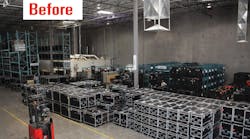Dan Souwand and his staff became students of the five S's of Lean so he could preserve his company's reputation among clients to whom only one big fat S counts: Showbiz.
Souwand is vice president of operations for Christie Lites, a lighting supply company with 12 outlets in major U.S. cities. But when they opened their Las Vegas operation in 2010, within a year they knew they had a problem. Their business in Vegas had grown beyond anyone's expectations and the warehouse could no longer store the vast inventory of lighting supplies required to meet their clients' needs. Moving to a new building was not an option.
"We didn't' want to move because we had an attractive lease," says Souwand, "but even when we looked at elaborate racking plans and reach trucks, we still didn't have enough space to meet current needs and allow for future growth. That's when we decided we needed to create a warehouse of the future."
That required finding a way to not only make better use of their existing space, but also to make better use of the time and space it took to move their lighting systems to client sites.
Starting with their own warehouse, Christie Lites found a high-density storage system (the Automha Autosat Shuttle System, www.automhausa.com) which could use almost all available floor space as storage space. There are no aisles and no need for an entire fleet of reach trucks. The racking can reach the ceiling and still every product is readily available. Every storage slot can be used, with no "honeycombing" of empty spaces.
Christie Lites found their greatest advantage was the time and trouble savings from not having to train order fillers to find certain products in certain aisles when putting together a customer's order for shipping. An operator punches in the codes and the correct products are automatically delivered in the correct sequence to the pick-up site. This eliminated order filling mistakes.
The shuttle system gives them enough storage space to meet current and future needs in the same warehouse footprint. Products are now stocked and retrieved faster, more accurately and with 50% less labor and fewer pieces of equipment. And by finding a way to standardize the packaging for various shapes and sizes of its lighting products, Christie Lights was able to put its logistics efficiency on the road.
Christie's clients use stage lights, which come in many shapes and sizes. Because trucks were rented to carry the lights to each event, a great deal of time was spent trying to fit the different shaped boxes into the back of a truck so as to use every inch of space. Christie realized that anything they might be gaining in reduced truck rental costs, they were losing in time and labor costs. That's what inspired the "Christie case system," which uses same-size product containers. They are constructed to protect the fragile lights and to stand up to the rigors of constant banging and abuse during the fast-paced set-ups and break-downs at events.
Now trucks can be loaded in a few minutes. The amount of space and the number of trucks required can be calculated accurately, well in advance. Products arrive undamaged and ready to create the lighting effects the client envisioned.
Even more important is the time saved in set break down. Many venues bring one show in right after another and the amount of time to set up for a performance is a critical factor in a venue's profitability. Because Christie Lites are all taken down quickly, packed into the uniform cases, loaded on a truck and removed from the site within a few hours of the show's finish, the new show can begin setting up immediately.
Another Christie innovation was standardized testing for all its lights. For years, other lighting companies would just unload at the warehouse, turn the lights on to see if they worked and then put them back into stock. Christie realized that a light's intensity or diffusion effect was the critical measure of its ability to give the customer the effect they wanted for their show. So Christie developed a light testing system that tests all lights in a special standardized lighting environment so that each light maintains its characteristics and substandard products never leave the warehouse.
"We can now see that our savings in rent and labor alone will pay back the capital cost [on the storage system] in just over three years," says Souwand. "After that those savings will go straight to our bottom-line every year after that. We're currently working to integrate this system into all our other major warehouses."
Nikki Ong is business growth specialist with Khách Customers, www.khachusa.com.





